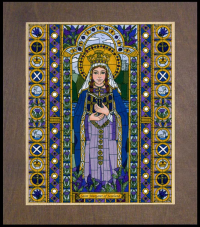
Feast day: 16 November
Margaret of Scotland was a member of the House of Wessex. She was the daughter of the exiled Edward and his wife Agatha, and the granddaughter of Edmund Ironside, King of England, who had fought valiantly against the Vikings but was eventually defeated by Canute who became King. He sent the infant Edward and his brother to the court of the Swedish King and then they made their way to Kievan Rus, the first East-European state. As an adult Edward went to Hungary and supported Andrew I in his bid for the Hungarian crown. Margaret was born in Hungary in about 1045. Her brother Edgar Atheling and her sister Cristina were also born in Hungary. Margaret was brought to England with the rest of her family when her father, Edward, was recalled in 1057 as a claimant to the throne of their childless great-uncle Edward the Confessor. However, Edward died immediately after landing. Although Edgar Atheling was a possible successor, Harold Godwinson was selected and on his defeat and death at the Battle of Hastings William the Conqueror became king. He took Edgar to Normandy, returning him to England in 1068. The family then fled to Northumbria. According to tradition, Agatha decided to leave Northumbria with her children and return to the continent. However, they were shipwrecked on the coast of Scotland in 1068. King Malcolm III gave them refuge. The place where they landed is known today as St Margaret’s Hope.
Malcolm III, also called Canmore, was a widower with two sons, Donald and Duncan. Marriage to Margaret, of the House of Wessex, would have been advantageous. The wedding took place in 1070. Subsequently Malcolm made several raids into Northumbria to support the claims of his brother in law Edgar but without any success.
Margaret and Malcolm had eight children. Three became Kings of Scotland, a daughter Edith (renamed Matilda) married Henry I of England, and another son became Abbot of Dunkeld, Perth and Kinross. Turgot, Bishop of St Andrews, wrote a life of Margaret at the request of her daughter, Queen Matilda. He credits Margaret with having a civilising influence on her husband by reading him stories from the bible. She instigated religious reform, preferring the practices of the continent (with which she had grown up) to those of the Scottish church. She did this on the advice of Lanfranc, a future Archbishop of Canterbury. She encouraged synods, and was present for discussions which tried to correct religious abuses such as simony, usury and incestuous marriage. She promoted the arts and education. Malcolm supported her in her works and he often consulted her on state affairs. She was considered the model of a just ruler and guided her husband and son David in this direction.
She performed many charitable works, serving orphans and the impoverished every day before she ate and washing the feet of the poor in imitation of Christ. She rose at midnight every night to attend the liturgy. She invited the Benedictines to establish a monastery in Dumfermline, Fife, in 1072 and established ferries at Queensferry and North Berwick to assist pilgrims travelling from the south of the Firth of Forth to St Andrews in Fife. She and Malcolm founded many other churches. She used a cave on the banks of Tower Burn in Dumfermline as a place of prayer. St Margaret’s Cave is now covered with a car park but is open to the public. She also instigated the restoration of Iona Abbey. She is known to have interceded for the release of fellow English exiles who had been forced into serfdom by the Norman conquest. She visited the sick and nursed them.
Margaret devoted much of her time to prayer, devotional reading and ecclesiastical embroidery. Malcolm had her books decorated in gold and silver. She personally guided the education of her children, punishing them if they misbehaved.
Malcolm and the eldest son Edward were killed in the battle of Alnwick against Robert de Mowbray, the Northumbrian Earl of Northumberland, who had ambushed them. Much of modern Cumbria was claimed by the Scots and Malcolm had invaded it in 1093. Margaret was told of the news by her son Edgar. She had been ailing and she died shortly after. Malcolm was buried in Tynemouth Abbey, but removed by his son Alexander III and buried in Dumfermline Abbey.
Margaret was canonised by Pope Innocent IV in 1250 and Malcolm and Margaret were buried together beside the altar. Their remains were moved from Dumfermline Abbey by Abbot George Durie to safeguard them from the Protestant Reformers. They were eventually enshrined in the Escorial, near Madrid, at the instigation of King Philip II.
Several churches around the world are dedicated to St Margaret, the oldest being St Margaret’s chapel in Edinburgh Castle. Queen Margaret University in Edinburgh was named after her as she personifies the values of community service and enhancement of the quality of life that the university promotes.
St Margaret, Queen of Scotland, pray for us.